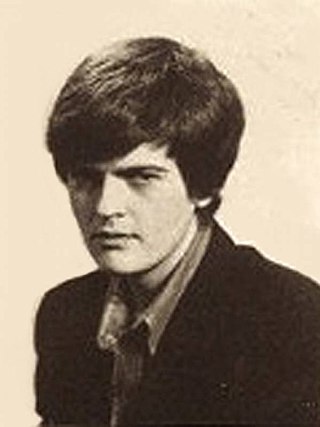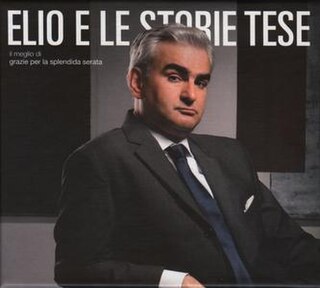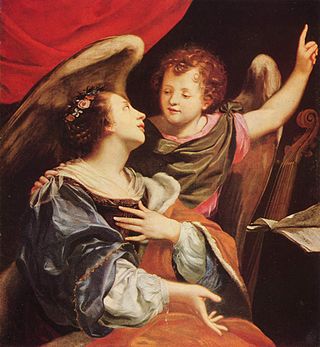Related Research Articles

The Mass is a form of sacred musical composition that sets the invariable portions of the Christian Eucharistic liturgy, known as the Mass.

The Messa da Requiem is a musical setting of the Catholic funeral mass (Requiem) for four soloists, double choir and orchestra by Giuseppe Verdi. It was composed in memory of Alessandro Manzoni, whom Verdi admired. The first performance, at the San Marco church in Milan on 22 May 1874, marked the first anniversary of Manzoni's death.

Loyset Compère was a Franco-Flemish composer of the Renaissance. Of the same generation as Josquin des Prez, he was one of the most significant composers of motets and chansons of that era, and one of the first musicians to bring the light Italianate Renaissance style to France.
The ordinary, in Catholic liturgies, refers to the part of the Mass or of the canonical hours that is reasonably constant without regard to the date on which the service is performed. It is contrasted to the proper, which is that part of these liturgies that varies according to the date, either representing an observance within the liturgical year, or of a particular saint or significant event, or to the common which contains those parts that are common to an entire category of saints such as apostles or martyrs.

Missa brevis usually refers to a mass composition that is short because part of the text of the Mass ordinary that is usually set to music in a full mass is left out, or because its execution time is relatively short.
The Missa Luba is a setting of the Latin Mass sung in styles traditional to the Democratic Republic of Congo. It was composed by Father Guido Haazen, a Franciscan friar from Belgium, and originally celebrated, performed, and recorded in 1958 by Les Troubadours du Roi Baudouin, a choir of adults and children from the Congolese town of Kamina in Katanga Province. It would later become the partial basis for a Congolese usage of the Ordinary Form of the Roman Rite Mass, the Zaire Use.

Tiziano Sclavi is an Italian comic book author, journalist and writer of several novels. Sclavi is most famous as creator of the comic book Dylan Dog in 1986, for Italian publishing house Sergio Bonelli Editore. More than 300 issues have appeared in the series, which has sold millions of copies. It has been in collaboration with several artists, including Claudio Villa, Corrado Roi, Gustavo Trigo, Carlo Ambrosini, Luigi Piccatto, Angelo Stano, Mike Mignola, Andrea Venturi, Giampiero Casertano and Bruno Brindisi.
The Tournai Mass is a polyphonic setting of the mass from 14th-century France. It is preserved in a manuscript from the library of the Tournai Cathedral.

Teodulo Mabellini was an Italian composer.

The Missa La sol fa re mi is a musical setting of the mass by Josquin des Prez, first published in 1502. It is one of his most famous masses, and one of the earliest and most renowned examples of the soggetto cavato technique – the technique of deriving musical notes from the syllables of a phrase, in this case "Lascia fare mi".
Most of Johann Sebastian Bach's extant church music in Latin—settings of the Mass ordinary and of the Magnificat canticle—dates from his Leipzig period (1723–50). Bach started to assimilate and expand compositions on a Latin text by other composers before his tenure as Thomaskantor in Leipzig, and he continued to do so after he had taken up that post. The text of some of these examples by other composers was a mixture of German and Latin: also Bach contributed a few works employing both languages in the same composition, for example his early Kyrie "Christe, du Lamm Gottes".
Francesco Falconi is an Italian fantasy writer.
The Sanremo Music Festival 2007, officially the 57th Italian Song Festival, was the 57th Sanremo Music Festival, held at the Teatro Ariston in Sanremo. The show was held during the five nights between 27 February 2007 and 3 March 2007.

The Missa brevis No. 7 in C major, K. 258, is a mass composed by Wolfgang Amadeus Mozart in 1776. It is scored for SATB soloists, SATB choir, violin I and II, 2 oboes, 2 clarini, 3 trombones colla parte, timpani and basso continuo.
The Missa Gaudeamus is a musical setting of the Ordinary of the Mass by Franco-Flemish composer Josquin des Prez, probably composed in the early or middle 1480s, and published in 1502. It is based on the gregorian introit Gaudeamus Omnes and its setting is for four voices.

The musicarello is a film subgenre which emerged in Italy and which is characterised by the presence in main roles of young singers, already famous among their peers, and their new record album. In the films there are almost always tender and chaste love stories accompanied by the desire to have fun and dance without thoughts. Musicarelli reflect the desire and need for emancipation of young Italians, highlighting some generational frictions. The genre began in the late 1950s, and had its peak of production in the 1960s.

Il meglio di Grazie per la splendida serata is a box by Elio e le Storie Tese, featuring three CDs of the best performances from the 2005 CDs brulé, instant CDs of their live performances immediately sold after the concert, therefore without any afterwards correction.
I Tubi Lungimiranti was a musical group formed in Fano, Italy in 1964. The group was part of the 1960s Italian Beat music movement. They later became a cult group for Dirty Acoustics and Garage Beat.

The Messa di Santa Cecilia is a religious work by Alessandro Scarlatti, written in 1720 for five soloists (SSATB), choir and orchestra, commissioned by and dedicated to cardinal Francesco Acquaviva of Aragona.

The Messa da requiem in D minor (1835) is a musical setting of the Catholic funeral mass (Requiem) by Italian opera composer Gaetano Donizetti. It is scored for five soloists, mixed chorus and orchestra. A performance lasts about 62–75 minutes.
References
- 1 2 3 "Youth Masses, Black Skin, and Italian Beat Music". i-Italy. RIPRODUZIONE VIETATA. Retrieved August 8, 2015.
- ↑ Tiziano Tarli, Beat italiano. Dai capelloni a Bandiera gialla, edizioni Castelvecchi, Roma 2005; pag. 127
- ↑ Claudio Pescetelli, La messa beat, pubblicato sul n° 39 di Jamboree
- 1 2 3 4 King, Pamela (2013). Angel with Drumsticks. Rerifar. ISBN 978-0-9875412-1-5 . Retrieved January 4, 2016.
- ↑ "Angel And The Brains / I Barrittas* / The Bumpers (2) – La Messa Dei Giovani (original release)". Discogs. Discogs®. Retrieved January 4, 2016.
- ↑ "Angel And The Brains / I Barrittas* / The Bumpers (2) – La Messa Dei Giovani (re-issue)". Discogs. Discogs®. Retrieved January 4, 2015.
- ↑ "The Bumpers". 45cat. 45cat website. Retrieved January 4, 2016.